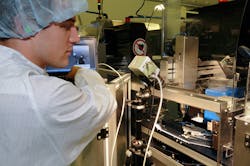Mikrotron cameras help drug-dispenser manufacturer optimize manufacturing processes
Nemera (La Verpillière, France) designs, develops, and manufactures drug-delivery devices for the pharmaceutical, biotechnology, and generic industries. Over the past decade, imaging technology by Mikrotron (Poway, CA) has supported Nemera's efforts for improvement of its manufacturing processes by detecting machinery defects invisible to the human eye at Nemera's site in Neuenburg, Germany. One of four worldwide plants, the Neuenburg location produces drug-dispensing systems made of thermoplastics. Precision injection-molded parts are assembled by rotary and linear high-speed lines using ultrasonic welding, automatic packing, and robots.
Nearly a decade ago, the Nemera production team began to explore a more-effective means of analyzing the rapid injection molding and assembly machinery in the Neuenburg plant, which had been malfunctioning at higher speeds without explanation. To overcome this problem, the team explored ways to capture millisecond-by-millisecond video images of the machinery operating for analysis.
After researching several high-speed video cameras, three vendors, including Mikrotron, were shortlisted. Each vendor was asked to put their cameras through a battery of tests in identical scenarios. According to Mikrotron, its MotionBLITZ Cube high-speed camera was deemed best due to its sharp resolution, ease of mobility, and circular buffer that allows capture video capture without a PC connection. Mikrotron also listed the following capabilities as factors: modular software architecture, internal triggering functions, external control capability via machine signals, and auto-trigger. The auto-trigger reacts to specific changes in the image content and can capture sporadic events.
Improving syringe production
Nemera employees carried out 25 studies in various areas of production in the first six months after acquiring the camera. In one example, a study examined insulin syringe production. At production rates of approximately 200 pieces per minute, components were being damaged, leading to machine disruptions as well as waste. However, when the machines were programmed for slower production, everything functioned perfectly. The cause was not immediately apparent yet the insulin syringe components continued to be positioned incorrectly and damaged at the higher speeds. High-speed imaging was able to provide evidence of cause and effect: the grippers simply opened too soon when operated at the 200 piece-per-minute rate. The machine's control signal was recorded simultaneously in each video frame by the camera, demonstrating how many milliseconds early the grippers had opened. Following this, the machine was reprogrammed and efficiency was improved by 10%.
Ongoing testing using the Mikrotron camera over a period of ten years has produced time-based conclusions that were used to adjust machines and achieve optimization. Nemera uses the camera as a standard when it comes to installing new machinery and equipment to detect problems and sources of errors, says Mikrotron. In many cases, prior to purchasing machines, Nemera goes directly to the supplier and uses the Mikrotron camera to inspect the system.
For more information, see www.mikrotron.de/en.
Source: Mikrotron

John Wallace | Senior Technical Editor (1998-2022)
John Wallace was with Laser Focus World for nearly 25 years, retiring in late June 2022. He obtained a bachelor's degree in mechanical engineering and physics at Rutgers University and a master's in optical engineering at the University of Rochester. Before becoming an editor, John worked as an engineer at RCA, Exxon, Eastman Kodak, and GCA Corporation.
